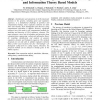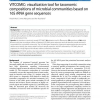932 search results - page 60 / 187 » Sequence Complexity for Biological Sequence Analysis |
BMCBI
2008
14 years 10 months ago
2008
Background: This paper discusses the problem of automated annotation. It is a continuation of the previous work on the A4-algorithm (Adaptive algorithm of automated annotation) de...
BIOCOMP
2009
14 years 7 months ago
2009
- Identification and annotation of all the functional elements in the genome, including genes and regulatory sequences, is a fundamental challenge in genomics and computational bio...
113
click to vote
BMCBI
2006
14 years 10 months ago
2006
Background: Existing biological databases support a variety of queries such as keyword or definition search. However, they do not provide any measure of relevance for the instance...
BMCBI
2010
14 years 10 months ago
2010
Background: Sequencing of environmental DNA (often called metagenomics) has shown tremendous potential to uncover the vast number of unknown microbes that cannot be cultured and s...
100
click to vote
BMCBI
2010
14 years 10 months ago
2010
Background: Understanding the community structure of microbes is typically accomplished by sequencing 16S ribosomal RNA (16S rRNA) genes. These community data can be represented b...


